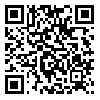Volume 17, Issue 3 (Vol 17,No.3, Atumn 2021 2021)
irje 2021, 17(3): 281-291 |
Back to browse issues page
Download citation:
BibTeX | RIS | EndNote | Medlars | ProCite | Reference Manager | RefWorks
Send citation to:



BibTeX | RIS | EndNote | Medlars | ProCite | Reference Manager | RefWorks
Send citation to:
Bayat S, Soori H, Asgarian F. Investigation of Association between Occupational Burnout and Driving Behavior among Shahid Beheshti University of Medical Sciences Staff. irje 2021; 17 (3) :281-291
URL: http://irje.tums.ac.ir/article-1-7039-en.html
URL: http://irje.tums.ac.ir/article-1-7039-en.html
1- Master's student, Faculty of Health and Safety, Shahid Beheshti University of Medical Sciences, Tehran, Iran
2- Professor of Epidemiology, Safety Promotion and Injury Prevention Research Center, Shahid Beheshti University of Medical Sciences, Tehran, Iran ,hsoori@yahoo.com
3- Assistant Professor of Epidemiology, Social Determinants of Health (SDH) Research Center, Kashan University of Medical Sciences, Kashan, Iran
2- Professor of Epidemiology, Safety Promotion and Injury Prevention Research Center, Shahid Beheshti University of Medical Sciences, Tehran, Iran ,
3- Assistant Professor of Epidemiology, Social Determinants of Health (SDH) Research Center, Kashan University of Medical Sciences, Kashan, Iran
Abstract: (2183 Views)
Background and Objectives: Healthcare providers suffer from occupational burnout due to emotional and physical pressures dealing with patients, which affects all aspects of living behavior. This study aimed to identify the association between occupational burnout and driving behavior among the employees of Shahid Beheshti University of Medical Sciences.
Materials and Methods: A descriptive- analytical study was conducted on 1629 employees of Shahid Beheshti University of Medical Sciences that were selected using random sampling. The employees completed a demographic questionnaire, Maslach Burnout Inventory, and Manchester Driver Behavior Questionnaire. The data were assessed based on a Likert scale.
Results: The results of occupational burnout analysis showed that the mean scores of emotional exhaustion (72.2-22.2-5.6%), cynicism (0.6-42.8-51.6) and professional inefficacy (31.8-21.8-46.4%) were mild, moderate and severe, respectively. The results also showed a significant relationship between depersonalization disorder and unintentional driving violations (P=0.026), driving-related errors and self-adequacy (p=0.023), and occupational burnout and driving behavior and the variables of gender, shift work, working hours, and educational groups. In general, occupational burnout was higher in women than in men (P<0.05).
Conclusion: Educational programs can improve low - risk driving ability among this group of employees. Psychological and counseling services should be reinforced in organizations so that the employees attain the ability to adapt to occupational psychological pressures to reduce occupational burnout in the long term.
Materials and Methods: A descriptive- analytical study was conducted on 1629 employees of Shahid Beheshti University of Medical Sciences that were selected using random sampling. The employees completed a demographic questionnaire, Maslach Burnout Inventory, and Manchester Driver Behavior Questionnaire. The data were assessed based on a Likert scale.
Results: The results of occupational burnout analysis showed that the mean scores of emotional exhaustion (72.2-22.2-5.6%), cynicism (0.6-42.8-51.6) and professional inefficacy (31.8-21.8-46.4%) were mild, moderate and severe, respectively. The results also showed a significant relationship between depersonalization disorder and unintentional driving violations (P=0.026), driving-related errors and self-adequacy (p=0.023), and occupational burnout and driving behavior and the variables of gender, shift work, working hours, and educational groups. In general, occupational burnout was higher in women than in men (P<0.05).
Conclusion: Educational programs can improve low - risk driving ability among this group of employees. Psychological and counseling services should be reinforced in organizations so that the employees attain the ability to adapt to occupational psychological pressures to reduce occupational burnout in the long term.
Type of Study: Research |
Subject:
Epidemiology
Received: 2022/01/18 | Accepted: 2021/12/1 | Published: 2021/12/1
Received: 2022/01/18 | Accepted: 2021/12/1 | Published: 2021/12/1
Send email to the article author
| Rights and permissions | |
 |
This work is licensed under a Creative Commons Attribution-NonCommercial 4.0 International License. |





